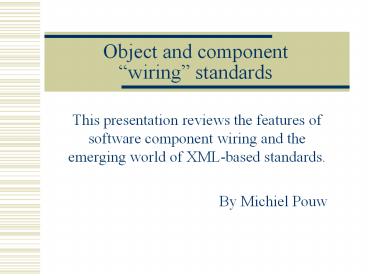Object and component wiring standards - PowerPoint PPT Presentation
1 / 23
Title:
Object and component wiring standards
Description:
None of these mechanisms is portable across platforms ... Cryptic, limited but compact. XML versus DTD. XML Schema itself is extensible ... – PowerPoint PPT presentation
Number of Views:76
Avg rating:3.0/5.0
Title: Object and component wiring standards
1
Object and component wiring standards
- This presentation reviews the features of
software component wiring and the emerging world
of XML-based standards. - By Michiel Pouw
2
Interproces communication
- Wide variety of mechanisms for IPC
- Files
- Pipes
- Sockect
- Shared Memory
3
Disadvantage / Advantage
- None of these mechanisms is portable across
platforms - They can easily be extended to work across
networks - But implementing complex interactions is painfull
and error-prone
4
Remote procedure calls
5
Disadvantage / Advantage
- Mapping all levels of communication on to a
single abstraction - In-process
- Interprocess
- Intermachine
- But also hides the significant cost difference
between calls
6
From procedures to objects
- A remote machine can be seen as an object and RPC
entry points are its methods - To be generally useful, an object-oriented
library must thus be distributed in source form - Not popular for component wiring
7
Back to basic Compound documents
- The components and compositition are intuitively
meaningfull for the user - The Xerox Star System
- Apples Hypercard
- Microsoft Visual Basic
- Later, web pages with embedded objects, such as
Java applets and ActiveX controls added a new
dimension
8
The rise of XML
- Useful for representing any structured and
semi-structured data - Prefers tree-shaped data
- Can handle relational schemas
- Even binary data using a standard encoding
- New applications of XML arise by the day
9
The rise of XML (2)
- Browsers directly support displaying and
exploring XML documents - Wide range of tools for generic support
- XML can be used as common language among
applications of independent origin and operation - XML takes the notion of wiring standards from
the level of protocols and wire formats to the
level of durable data representation
10
Structure of XML
- Three important catagories
- XML elements
- XML attributes
- Unstructured text
- Elements and attributes like HTML
- lttag attr1val1 attr2val2gt
11
Structure of XML (2)
- Strict nesting is required
- Unstructured text is properly quoted
- A single unique root element
- Elements
- lttag gt Scope of tag lt/taggt
- lttag /gt
- lt? ?gt Meta-information
- lt!-- --!gt Comments
12
Structure of XML (3)
- Within an elements scope nested elements or
unstructured text can be placed - Multiple nested elements can have the same tag
- Ordering of nested elements matters
- Attributes of an element form a set
- Different names
- Ordering is irrelevant
13
Document type descriptors
- DTDs were originally used before XML
- Cryptic, limited but compact
14
XML versus DTD
- XML Schema itself is extensible
- Much richer and expressive then DTD
- Part of XML Schema is a flexible and expressive
data type description system - Use XML to define a standard metaschema for other
XML documents
15
XML support standards
- Xpath
- Tag separation by slashes (/)
- Xpointer
- Extends the set of idenifible locations in XML
- Xlink
- Focuses on the links among XML documents
- XML stylesheet language
- Transform an XML document into another form
16
XML document object and streaming model
- XML document object model presents XML documents
as - Abstract data structures
- or as objects
- For large documents this requires
- Random acces
- or streaming reading and writing
17
Simple object acces protocol
- XML documents can be used as self-describing
messages - Can be used for remote object invocation
- The SOAP standard provides standard ways to
- Describe the addressee of an invocation
- Encode a wide range of typical programming data
types into invocation messages - Define what parts of a message must be understood
or can be ignored
18
XML web services
- With SOAP web services can be established
- These services offer computational services to
other systems - Similar to deployed components from a client
point of view - Standard interfaces
- Implementation is not revealed
19
XML web services (2)
- Not addressed at the level of SOAP
- Authentication of communication parties
- Encryption of exchange information
- Compensation agreements
- Subscription
- Billing
- Another standard is needed for these issues
20
Web services description language
- WSDL documents are based on XML
- Defines an extensible framework to describe web
services. - Input and output messages are defined by WSDL
ports - WSDL ports are grouped into WSDL services
21
Web services and programming models
- Ports on services are similar to methods on
interfaces - Tempting to model web service invocations as
synchronous remote method calls - Also tempting to think of web service
implementations as classes that implement the
ports of a service as methods
22
Web services and programming models (2)
- Special nature of web-distributed services
- Unpredictable latencies
- Flexible host selection due load balancing
- Failures can occur at any time
- A better model should use asynchronous call
models against web services, similar to those
found in message queuing systems
23
Conclusion
- Many other issues need to be addressed in the
world of web services that have previously been
addressed in remote procedure, distributed
object, and messaging approaches































